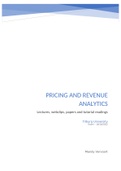Samenvatting
Summary Pricing and Revenue Analytics lecture notes, articles, webclips and tutorial readings
- Instelling
- Tilburg University (UVT)
Summary: Pricing And Revenue Analytics at Tilburg University for Marketing Analytics - December 2022. In this document I summarized all lectures, including the webclips, the compulsory readings and the readings for the tuorials of the course Pricing and Revenue Analytics. It also contains several ...
[Meer zien]




